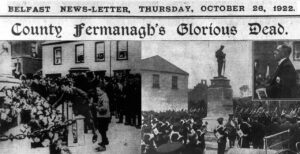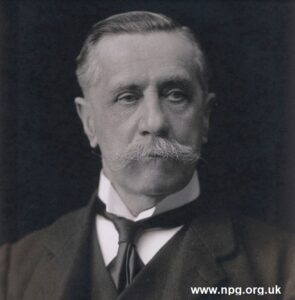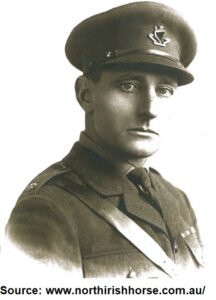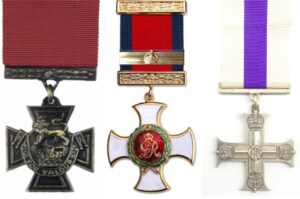County Fermanagh War Memorial
By Nigel Henderson
In April 1919, John Ernest Francis Collum, Lord Lieutenant for County Fermanagh, convened a public meeting in Enniskillen Town Hall on 10th April 1919 to discuss the provision of a public memorial to commemorate the men from County Fermanagh who gave their lives in the Great War. An Executive Committee was formed and subscriptions were invited from the public. In the following months and years, Honorary Secretary, Mr William Copeland Trimble who owned the Imperial Reporter, published lists of the subscriptions to the Fermanagh War Memorial Appeal. In June 1920, a meeting of the subscribers was held to determine the form of the memorial. Colonel Richardson, seconded by Dr. Fitzgerald proposed,
“That suitable Memorial Tablets be erected in a Public Place in Enniskillen, and that the balance be given towards the County Hospital to augment the Improvement Fund.”
Although this proposal was supported by the subscribers at the well-attended meeting, the Fermanagh Times published a series of letters raising objections to the form that the memorial would take. In July, the Executive Committee announced that formal objections to the proposed plans could be submitted. In September 1920, the decisions made at the June 1920 meeting were rescinded at special meeting of the subscribers.
In December 1920, the Fermanagh War Memorial Committee examined several designs and selected two designs for consideration by the subscribers – both featured statues of soldiers, one on a Portland stone pedestal and one on a rough granite pedestal. A meeting of the subscribers later in the month selected the design that had been submitted by Messrs. Gafflin of the Carrara Marble Works in London. This design featured a white Portland stone pedestal, reached by three steps, and surmounted by a life-size bronze statue of a soldier in full Great War uniform, in a reverent posture with reversed arms. The whole monument was to be 20 feet in height and would cost £1,600 – which equates to just over £70,000 in current terms.
In October 1921, the War Memorial Committee reported that 574 names of fatalities had been gathered and that it expected that the list would exceed 600 names. The committee invited the Lord Lieutenant of Ireland, being the highest state official and the King’s personal representative on the island of Ireland, to unveil the war memorial. The unveiling ceremony was scheduled to take place at 12:40 on Wednesday 25th October 1922 as part of a Vice-Regal Visit to Northern Ireland.
 On that date, Edmund Bernard FitzAlan-Howard, 1st Viscount FitzAlan of Derwent, travelled from Belfast to Enniskillen, accompanied by Sir James Craig, Prime Minister of Northern Ireland. Mr A W G Ritchie, Town Clerk, read the council’s address to the Lord Lieutenant, which included these words, “As in that war [the Second Boer War], so in the Great War, the unflinching courage and unconquerable spirit of the Fermanagh men, not alone in the Inniskilling Regiments, but also in the many other branches of His Majesty’s forces in which they served, earned for them undying glory; and the names of the men emblazoned on the memorial which your Excellency will today unveil will live forever in our hearts and memories.”
On that date, Edmund Bernard FitzAlan-Howard, 1st Viscount FitzAlan of Derwent, travelled from Belfast to Enniskillen, accompanied by Sir James Craig, Prime Minister of Northern Ireland. Mr A W G Ritchie, Town Clerk, read the council’s address to the Lord Lieutenant, which included these words, “As in that war [the Second Boer War], so in the Great War, the unflinching courage and unconquerable spirit of the Fermanagh men, not alone in the Inniskilling Regiments, but also in the many other branches of His Majesty’s forces in which they served, earned for them undying glory; and the names of the men emblazoned on the memorial which your Excellency will today unveil will live forever in our hearts and memories.”
The front face of the pedestal bore the insignia of the Inniskilling regiments, bronze crossed rifles, and the inscription “Our Glorious Dead 1914-1918″. The Fermanagh Times reported that the names inscribed on the sides “total about six hundred and fifty, and represented practically every unit in His Majesty’s Forces“. The names are ordered by Service, then Rank, and then Alphabetically. The first names belong to two Royal Navy Sub-Lieutenants followed by fatalities from the Royal Inniskilling Fusiliers, other Irish Regiments, other units of the British Expeditionary Force, and, finally, the Dominion and Indian forces. The Enniskillen Urban District Council took over responsibility for the war memorial in December 1922.
Twenty of the men named on the memorial were awarded British gallantry awards. Three were recipients of the Victoria Cross, five received the Distinguished Service Order (with a Bar being awarded to one man), two were awarded the Distinguished Conduct Medal, five men were awarded the Military Cross (two of them also being awarded Bars), and eight men received the Military Medal. The highest decorated man on the memorial was Lieutenant-Colonel Richard Annesley West who was awarded the Victoria Cross, the Distinguished Service Order (with Bar), the Military Cross, and was Mentioned in Despatches on two occasions.
 Richard Annesley West was born on 26th September 1878 at Oxford Street in Cheltenham to Augustus George West and Sara West nee Eyre and the family was living at Tullynagowan near Brookborough by 1901. On 8th January 1900, Richard West enlisted at Newbridge with the 45th Company, Imperial Yeomanry (also known as the Irish Hunt Squadron) and served in the Boer War from 13th March 1900 to 4th March 1901, seeing action at Lindley, Dewetsdorp and Riddesberg. After being discharged, he returned to South Africa where he married Maud Ethel Cushing on 16th July 1909. On the outbreak of war, Richard West sought a commission in the North Irish Horse but, as the War Office had not approved his commission, he enlisted as a Trooper and sailed for France with C Squadron on 20th August 1914. His commission, backdated to 11th August, was confirmed in September 1914 and he was later attached to the North Somerset Yeomanry and Tank Corps. Richard West commanded B Squadron of the North Somerset Yeomanry during the Battle of Arras and was awarded the Distinguished Service Order for his actions on 11th April 1917: “His squadron was sent forward to reinforce the right flank of the Brigade under very heavy shell and machine-gun fire. By his excellent example, rapid grasp of the situation and skilful disposition of his squadron, he did much to avert an impending counter-attack. He had shown great ability in command since July 1915“. Richard West was subsequently attached to the Tank Corps and was wounded on 9th August 1918 whilst commanding a company of Whippet tanks in the fighting east of Villers-Bretonneux. He was awarded the Military Cross for his actions that day: “For conspicuous gallantry and good leadership. He commanded a company of light Tanks with great skill. He had two horses shot under him during the day, and he and his orderly killed five of the enemy and took seven prisoners. He rendered great services to the cavalry by his personal reconnaissances, and later in the day, under heavy machine-gun fire, he rallied the crews of disabled Tanks and withdrew them with great skill. He set a splendid example of courage and devotion to duty throughout the operations.”
Richard Annesley West was born on 26th September 1878 at Oxford Street in Cheltenham to Augustus George West and Sara West nee Eyre and the family was living at Tullynagowan near Brookborough by 1901. On 8th January 1900, Richard West enlisted at Newbridge with the 45th Company, Imperial Yeomanry (also known as the Irish Hunt Squadron) and served in the Boer War from 13th March 1900 to 4th March 1901, seeing action at Lindley, Dewetsdorp and Riddesberg. After being discharged, he returned to South Africa where he married Maud Ethel Cushing on 16th July 1909. On the outbreak of war, Richard West sought a commission in the North Irish Horse but, as the War Office had not approved his commission, he enlisted as a Trooper and sailed for France with C Squadron on 20th August 1914. His commission, backdated to 11th August, was confirmed in September 1914 and he was later attached to the North Somerset Yeomanry and Tank Corps. Richard West commanded B Squadron of the North Somerset Yeomanry during the Battle of Arras and was awarded the Distinguished Service Order for his actions on 11th April 1917: “His squadron was sent forward to reinforce the right flank of the Brigade under very heavy shell and machine-gun fire. By his excellent example, rapid grasp of the situation and skilful disposition of his squadron, he did much to avert an impending counter-attack. He had shown great ability in command since July 1915“. Richard West was subsequently attached to the Tank Corps and was wounded on 9th August 1918 whilst commanding a company of Whippet tanks in the fighting east of Villers-Bretonneux. He was awarded the Military Cross for his actions that day: “For conspicuous gallantry and good leadership. He commanded a company of light Tanks with great skill. He had two horses shot under him during the day, and he and his orderly killed five of the enemy and took seven prisoners. He rendered great services to the cavalry by his personal reconnaissances, and later in the day, under heavy machine-gun fire, he rallied the crews of disabled Tanks and withdrew them with great skill. He set a splendid example of courage and devotion to duty throughout the operations.”
 Richard West was awarded the Bar to his DSO for his actions on 21st August 1918 at Courcelles: “For conspicuous gallantry during an attack. In addition to directing his tanks, he rallied and led forward small bodies of infantry lost in the mist, showing throughout a splendid example of leadership and a total disregard of personal safety, and materially contributed to the success of the operations. He commanded the battalion most of the time, his C.O. had being early killed.” Lieutenant-Colonel
Richard West was awarded the Bar to his DSO for his actions on 21st August 1918 at Courcelles: “For conspicuous gallantry during an attack. In addition to directing his tanks, he rallied and led forward small bodies of infantry lost in the mist, showing throughout a splendid example of leadership and a total disregard of personal safety, and materially contributed to the success of the operations. He commanded the battalion most of the time, his C.O. had being early killed.” Lieutenant-Colonel
Richard Annesley West was commanding 6th Battalion Tank Corps when he was Killed in Action on 2nd September 1918 at the age of 40 and is buried in Mory Abbey Military Cemetery. He was awarded the Victoria Cross for his action on the day that he died: “On 2 September at Vaulx-Vraucourt, he arrived at the front line when the enemy were delivering a local counter-attack. The infantry battalion had suffered heavy officer casualties and realizing the danger if they gave way, and despite the enemy being almost upon them, Colonel West rode up and down in face of certain death, encouraging the men. He fell, riddled with bullets. His magnificent bravery at a critical moment so inspired the infantry that the hostile attack was defeated.” The Cheltenham Civic Society erected a blue plaque at the house where he was born.
 There was one woman recorded on the war memorial when it was unveiled – Marion Georgina Graham from Lisnaskea. She was born on 9th February 1880 at Casson in the Lisbellaw sub-district to Noble Graham and Dinah Noble (nee Carter) who farmed 53 acres of land at Drummack near Lisnaskea. Marion went into nursing and worked at the Meath Hospital in Dublin before joining the Colonial Nursing Service. She was posted to Nigeria on 27th August 1914 and had a period of home leave between October 1915 and February 1916. Marion was allowed a further period of home leave in 1917 and set sail from Lagos onboard SS Abosso, which was carrying passengers, mail and 3,500 tons of West African produce to Liverpool. SS Abosso, which had been constructed at Harland and Wolff in 1912, was torpedoed and sunk 180 miles from Fastnet by German submarine U-43 on the 24th April 1917. The Commonwealth War Graves Commission commemorates 25 crewmen and a Royal Navy seaman but does not commemorate the civilian passengers who died, including Marion Graham.
There was one woman recorded on the war memorial when it was unveiled – Marion Georgina Graham from Lisnaskea. She was born on 9th February 1880 at Casson in the Lisbellaw sub-district to Noble Graham and Dinah Noble (nee Carter) who farmed 53 acres of land at Drummack near Lisnaskea. Marion went into nursing and worked at the Meath Hospital in Dublin before joining the Colonial Nursing Service. She was posted to Nigeria on 27th August 1914 and had a period of home leave between October 1915 and February 1916. Marion was allowed a further period of home leave in 1917 and set sail from Lagos onboard SS Abosso, which was carrying passengers, mail and 3,500 tons of West African produce to Liverpool. SS Abosso, which had been constructed at Harland and Wolff in 1912, was torpedoed and sunk 180 miles from Fastnet by German submarine U-43 on the 24th April 1917. The Commonwealth War Graves Commission commemorates 25 crewmen and a Royal Navy seaman but does not commemorate the civilian passengers who died, including Marion Graham.
